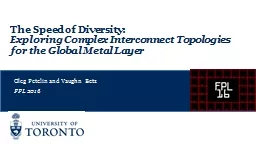PPT-The Speed of Diversity:
Author : pamella-moone | Published Date : 2017-05-06
Exploring Complex Interconnect Topologies for the Global Metal Layer Oleg Petelin and Vaughn Betz FPL 2016 Motivation The Metal Stack Poor wire RC scaling more
Presentation Embed Code
Download Presentation
Download Presentation The PPT/PDF document "The Speed of Diversity:" is the property of its rightful owner. Permission is granted to download and print the materials on this website for personal, non-commercial use only, and to display it on your personal computer provided you do not modify the materials and that you retain all copyright notices contained in the materials. By downloading content from our website, you accept the terms of this agreement.
The Speed of Diversity:: Transcript
Download Rules Of Document
"The Speed of Diversity:"The content belongs to its owner. You may download and print it for personal use, without modification, and keep all copyright notices. By downloading, you agree to these terms.
Related Documents














